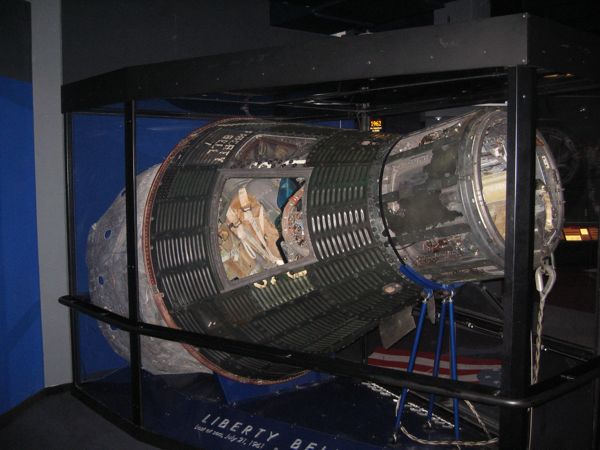|

|
  |
|
|
|

|
Liberty Bell 7 as displayed at Kennedy Space Center Visitor Complex. Landing bag is deployed and heat shield missing (not recovered). Sea corrosion is visible on forward section, but otherwise capsule held up very well. Paint survived not only reentry but the long stay on the ocean floor. Part of "UNITED STATES" is visible on either side of entry hatch. "LIBERTY BELL 7" can be seen below (left) of the window, along with the famous 'crack'. Gus Grissom said that it was the last time he would fly a capsule with a crack in it. |
Images by: Jim Gerard
Date: August 27, 2007 |
Mission information available from NASA |
 |
 |
 |
 |
 |
 |
|
|
|
Older Images
|
 |
 |
 |
 |
| Gus Grissoms "picture window" |
"Liberty Bell 7" and "crack" painted to its left |
Main hatch from front |
Periscope |
 |
 |
 |
 |
| Periscope |
Landing bag and aft bulkhead |
Landing bag side |
Damage from sea corrosion |
 |
 |
 |
 |
| Oblique view |
Liberty Bell 7 |
Access hatch |
Control Panel |
 |
 |
 |
|
| Parachute compartment with helicopter recovery hook |
Mercury dimes and Silver Certificate |
Mercury Trainer |
|
|
Images by: Jim Gerard
Date: June 19, 2000
|
 |
Lowell Grissom, brother of astronaut Gus Grissom
Photo by: Florida Today |
|
|
 |
 |
 |
 |
The first image of this spacecraft in over 35 years. This was taken off the video during the recovery attempt by Curt Newport sponsored by the Discovery Channel. Recovery is a joint effort between Newport, The Discovery Channel, and the Kansas Cosmosphere and Space Center, whose SpaceWorks restored the capsule (or at least stabilize its deterioration).
Location: Lies nearly 3 miles (4.8 km) deep in the Atlantic Ocean 516 miles (830 km) N.W. of Grand Turk Island
Photo by: Discovery Channel |
Dockside, Liberty Bell 7 finally reaches land. |
Section of Liberty Bell 7 outer skin. The painted name held up surprisingly well through reentry and the time on the ocean floor.
Photo by: Florida Today |
Liberty Bell 7 being restored at the KCSC. The inconel skin has been removed and placed on the back wall to reveal the frame and pressure vessel. Some deterioration can be seen in the parachute housing on the forward end. One notable skin panel is the one with the name.
Photo by: Florida Today |
|
Former Locations
|
- Atlantic Ocean floor, depth 15,000 feet (4.5 km), 300 nautical miles (550 km) southeast of Cape Canaveral
- Nationwide tour following restoration at KCSC, Hutchinson, KS
• Kennedy Space Center Visitor Complex from June 17, 2000 to Sept. 17, 2000
• The Children's Museum, Indianapolis from Oct. 7, 2000 to Jan. 7, 2001
• Liberty Science Center, Jersey City from Jan. 27, 2001 to June 3, 2001
• St. Louis Science Center, St. Louis from June 23, 2001 to Sept. 9, 2001
• The Tech Museum, San Jose from Sept. 29, 2001 to Jan. 6, 2002
• Boston Museum of Science, Boston from Jan. 26, 2002 to March 24, 2002
• Kirkpatrick Science & Air Museum, Oklahoma City from April 13, 2002 to June 16, 2002
• California Science Center, Los Angeles from June 29, 2002 to Sept. 15, 2002
• Denver Museum of Natural History, Denver from Oct. 5, 2002 to Jan. 5, 2003
• Kansas Cosmosphere and Space Center, Hutchinson, KS from Mar. 1 2003 to May 26, 2003
• Museum of Science and History, Ft. Worth from June 14, 2003 to Sept. 7, 2003
• ScienceCity, Kansas City, Missouri from September 26, 2003 to January 4, 2004
• Virginia Air and Space Center, Hampton, VA from ?, 2005 to ? 2005
• Kennedy Space Center Visitor Complex from ? to Sept. 15, 2006
(Please help reconstruct this itinerary)
|
|
|
|
|
|
|
|
|
|
|
|
|
|
|
Last update: Thursday, September 13, 2007
|
|
|
A Field Guide to American Spacecraft
by Jim Gerard
www.americanspacecraft.com
|
|
|
|



